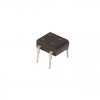I'd like to see if anybody has suggestions to power a low voltage AC device with DC. Here's the story: I purchased a doorbell chime which requires 16v AC continuous power to actuate a series of chimes. The doorbell chime also requires a separate circuit to initiate the chimes when the doorbell button is pushed. In total, the doorbell chime needs 4 wires: 2 from the 16v AC transformer, and 2 from the doorbell button.
The problem is that my electrician ignored the installation instructions and installed only 2 wires in the wall (which is now drywalled and painted) that make up the doorbell button circuit, so the doorbell chime won't work because it requires power after the doorbell is pressed. Rather than tearing up drywall to run more wires directly to the transformer, I'd like to see if it is feasible to supply power to the chime with a couple of 9v batteries in series. A competing chime uses this system as an alternative to continuous 16v AC power, and it doesn't have a big inverter as far as I can see, so it can be done, I just don't know what would be required. Any suggestions? Thanks!
The problem is that my electrician ignored the installation instructions and installed only 2 wires in the wall (which is now drywalled and painted) that make up the doorbell button circuit, so the doorbell chime won't work because it requires power after the doorbell is pressed. Rather than tearing up drywall to run more wires directly to the transformer, I'd like to see if it is feasible to supply power to the chime with a couple of 9v batteries in series. A competing chime uses this system as an alternative to continuous 16v AC power, and it doesn't have a big inverter as far as I can see, so it can be done, I just don't know what would be required. Any suggestions? Thanks!




